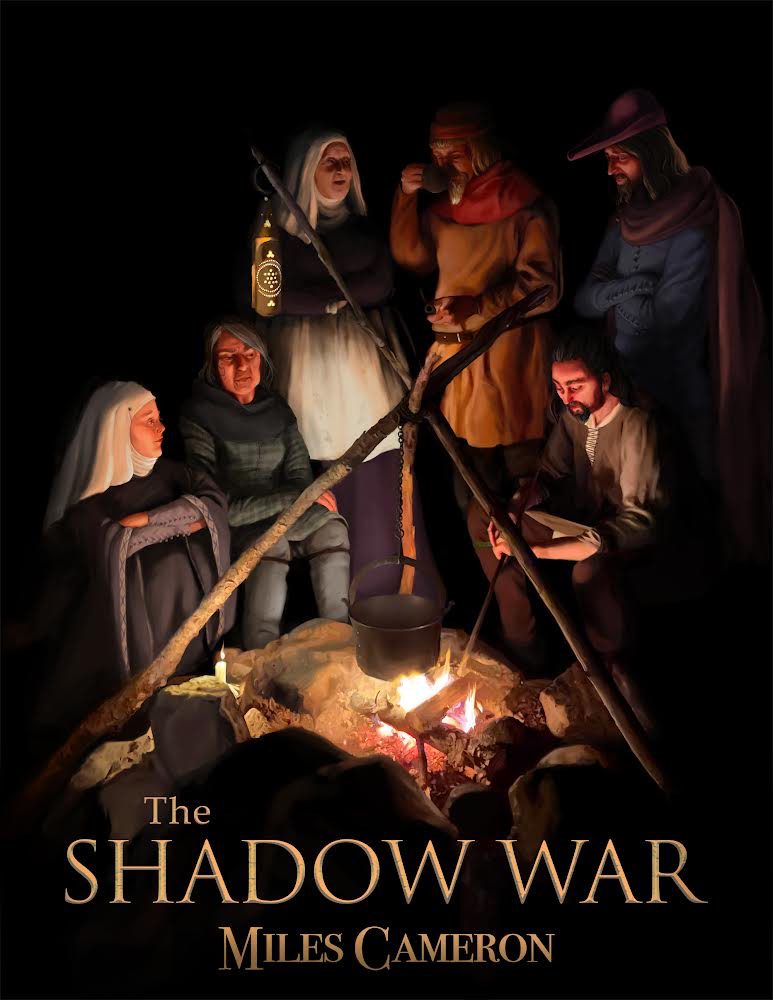
I don’t think that is will come as a surprise to any of you that Greece (along with Italy and England and the Adirondacks and southern Ontario and a few dozen other places) is one of the main inspirations to my writing. Greece inspired all of my ancient historical novels, which are placed there; in ‘The Green Count,’ my latest William Gold/Chivalry novel, William Gold spends a good deal of time on Lesvos; in my first fantasy Series, the ‘Traitorson’ series, Morea and the lands of the ‘Empire’ are transparently like aspects of the Peloponnese grafted onto other aspects of Thrace and Lesvos and Chios, all appended to Massachusetts. The upcoming ‘Masters and Mages’ series owes a great deal of terrain and feel to Greece.
The picture at the head of this blog, by the way, is of the ruins of a 14th century castle or fortification that Sarah and I discovered on a walk in north Lesvos. Three days ago. It was probably built by Francesco Gattelusi…
You may ask ‘why’ Greece is so full of inspiration. I could toss off a pat literary answer; after all, Pope and Byron and many other English writers have been inspired here. But my answer has to do with my love of history, and my love of landscape, and the sea, too. Greece has it all; the island of Lesvos, close to Turkey, may be the ultimate compilation of layers of history I’ve ever found. And to an aspect of experience that I try to convey when I write; I like to touch things, to feel them, to experience them. Discovering a castle or a ruin for myself (whether it is in a guidebook or not) is more moving than reading about it in a book, or seeing photos.
Like I say, Lesvos is often the wellspring. Sarah and I came here for our honeymoon; she wanted beaches, I wanted castles, and Lesvos was the place that offered both. So much history; and a meeting place, an instersection, for history….
This year, for example, marks the 650th anniversary of the Green Count’s crusade. To the best of my knowledge, the Green Count never went to Lesvos, but his ally, the pirate/adventurer turned great lord and loyal Byzantine subject, Francesco Gattelusi, formed up his fleet at Lesvos and set forth from here in 1367 to join forces with the Green Count. Gattelusi had, after a colourful career, been of signal service to Emperor John V, and he received an Imperial bride (John’s sister Maria) and the islands of Lesvos, Lemnos, and a few others as his own principality within a kingdom. The islands provided him with a rich power base; he hired good mercenaries from Italy to guard his castles (some of them English and Scots) and preyed on Turkish and Arab shipping. And when his father-in-law the Emperor was taken prisoner (N.B. a touchy point even today) by the Bulgarians, Gattelusi sent his fleet, probably the most powerful in the Eastern Mediterranean, to support the Green Count, who was also related to the Byzantine Emperor. He seems to have gone himself, the old pirate. Together, they took all the Turkish-held towns along the European side of the Dardanelles, and as they moved up the coast, they passed Troy (yes, that Troy) before storming Gallipoli (yes, that Gallipoli) in one of the more brilliant feats of arms of the later Middle Ages, Oh, and later that year, 650 years ago, their combined armies and fleets did indeed rescue the Emperor or at least finagle his release (it’s unclear what happened).
Cool story, eh? Read ‘The Green Count.’ It is out in a few days…
But I digress. The castle of Mythimna (Molyvos) has layers of stone from Bronze Age foundations to Archaic and Classical and Hellenistic and Roman and Byzantine and Gatelusi and Ottoman stonework; almost all of the Island’s history (if you count in repeairs by the modern Greek government) can be read in the curtain walls of Mythimna Castle. One of the largest naval battles of the Ancient world was fought here (Athens defeated Sparta, and then, in the best traditions of a democracy, the Athenians voted to execute the commanders of the victorious fleet.) In the same waters, in 1457, or 90 years after the Green Count’s team-up with Francesco Gatelusi, the pope’s strongman, Cardinal Trevisan, defeated a Turkish fleet here; same waters. (I use all that for Tom Swan, but the events are real.). Just to keep noting the connections, (yes, I loved that show) Trevisan’s Papal fleet was built with the money raised by the sale of indulgences. The indulgences that were printed on Guttenberg‘s press raised the money that funded Trevisan’s fleet and eventually so incensed Martin Luther that Protestantism was born. But indulgences were the tool that the church had to raise mony for crusade… you knew that, right?
And today I visit the other of my sacred historical places; the towering volcanic dome of Vigla in Skala Eressos. The dome itself is a world geological formation, registered as such by the UN; atop the hill is a bronze age citadel. It was fully fortified in the Archaic; Sappho‘s family ruled Eressos from here, and Sappho had her school on this hill.

Note that the statue says ‘Sappho of Eressos’. It’s nice when history offers you something easy and connected…

Vigla offers the entire panoply of history. It is beautiful; it features excellent oregano, the best on the island, and that makes for many adventures on the steep, sun-drenched slopes. Here you can find Archaic pottery and fourteenth century Genoese and Greek and Arab pottery, Hellenistic stars and Athenain blackware. Here Sappho taught here students…
Some say an army of horsemen,
some of footsoldiers, some of ships,
is the fairest thing on the black earth,
but I say it is what one loves.
Sappho
I love this stanza… I realize it’s supposed to be love poetry, but doesn’t is seem possible that Sappho’s partner was a gamer and there was some mockery involved?
Here gathered the ships of the Ionian Fleet; here the Greek rebels used a fire ship to sink the Turkish Admiral; here, in about 1380, the Gatelousi garrison (of Englishmen, according to local legend) ambushed a Turkish raid and rescued their captives. History happened here. The experience of the smell of the flowers, the smell of burning on the hillsides, the flocks of sheep moving on the roads, their bells, the sight of a thousand head of sheep milling around your frightened horse…
This is research.
Tomorrow and Tuesday I’ll be in museums in Mitilini and Athens, looking things up and checking on artifacts I’ll use in my novels; quite probably at the Benaki, looking at costumes for Cold Iron, my next Fantasy novel. But this is the research I love most… doing things. Touching the past.
In Greece.


Deep yet accessible, alive and inspiring, thanks for sharing.
Just re-reading a story set in S.M. Stirling’s ‘post-Change’ world, this one in Venice. Characters speak the odd Venetian dialect with ‘reflexive pronouns’ [?]: ‘I myself…’ and I immdeitaely thought of William Gold!